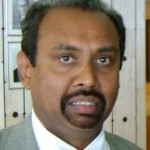Regime Change Not A Viable Solution ?

By S. V. Kirubaharan -December 8, 2013 |
The 1987 Indo- Lanka accord recognized the North East of the island of Sri Lanka as the hereditary land of the Tamil people. Under internationally agreed arrangement, the North and Eastern provinces were merged as one administrative unit.
Unfortunately less than a year after Mahinda Rajapaksa was elected as President, the merger of the North and Eastern provinces was brought to an end on 16 October 2006, after systematic manipulation. The President’s voice, the Janatha Vimukthi Peramuna – JVP and then Chief Justice, Sarath N. Silva played an important role in this.
The President who ordered the National anthem to be sung only in Singhalese and who scrapped the Ministry which handled human rights, continues to cheat the International community by chanting the sweet word, “reconciliation”. What is lacking for Mahinda Rajapaksa to implement a viable political solution for the people who have demanded their fundamental rights for more than six decades?
The excuse given by the government is that a problem which lasted three decades cannot be solved in two or three years. So, why did they assure the international community that as soon as terrorism was wiped out, the ethnic problem would be settled?
As far as the realities, experience and history are concerned, regime change in Sri Lanka is not a viable solution for accountability and reconciliation. It is a myth created by some stooges who see benefit in it for themselves. As far as the ethnic conflict is concerned, every government in power has wanted to find a pretext to justify not solving the ethnic problem, rather than find a solution. A few examples follow:
Two third majority
In 1970, Srimavo Bandaranaike had a two third majority in the parliament. She used that to strip away the minimum political safeguards that the Tamils had under the Soulbury constitution.
Ceylon became a “Republic” on 22 May 1972, ushering in a Sinhala-Supremacist Republican Constitution,which made Buddhism the state religion.
The leftist parties, the Lanka Sama Samaja Party – LSSP and the Communist Party – CP who were for equal rights and were in coalition with the Sri Lanka Freedom Party – SLFP, drafted the new constitution, and gave a prominent place for Buddhism and the Singhalese. They not only ignored the ethnic issue, they also removed the minimum protection provided in the Soulbury constitution . It is true that not all members of the LSSP and CP supported this view, but it cannot be denied that the leaders fully endorsed it.Read More

